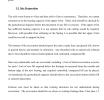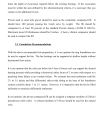Shimmy1
Senior Member
I have been asked to prepare a site for a large steel grain bin. It will be 72' diameter, and 110' tall. There was a geotechnical survey completed before construction of an identical bin about 6 years ago. At that time, the engineer allowed the base to set on 2.5' of compacted fill, which consisted of pit run sand/gravel. Since the plan is 7 years old, it was suggested to do a new one, but the customer has decided to roll the dice and use the old one. I'm not concerned at all about the sub-grade material, I know based on the location that it will be identical. What the customer is wanting to do is increase the depth of the modification from 2.5' to 4.5' to be safe.
What I'm wondering from you guys who read this is the material I'm planning on using has a small percentage of 3-5" rock in it. It's roughly 70% coarse sand, 25% rock from 0.25" to 1", 4% rock 1" to 3", and 1% rock 3" to 5". I am mining it out of a pretty deep pit, and in the process of pushing it up, piling it up, loading it, re-piling it onsite, I am able to shake out 99% of the bigger rock. Naturally, since it probably only has about 1% of rock larger than 3", I've reduced that to probably 0.1%. Is this going to be a problem in this situation? I'm only asking since the geotech says I should use material that passes 100% through a 3" sieve. I've attached a couple of snaps of the engineer's report. Sorry for the long-winded post.


What I'm wondering from you guys who read this is the material I'm planning on using has a small percentage of 3-5" rock in it. It's roughly 70% coarse sand, 25% rock from 0.25" to 1", 4% rock 1" to 3", and 1% rock 3" to 5". I am mining it out of a pretty deep pit, and in the process of pushing it up, piling it up, loading it, re-piling it onsite, I am able to shake out 99% of the bigger rock. Naturally, since it probably only has about 1% of rock larger than 3", I've reduced that to probably 0.1%. Is this going to be a problem in this situation? I'm only asking since the geotech says I should use material that passes 100% through a 3" sieve. I've attached a couple of snaps of the engineer's report. Sorry for the long-winded post.


